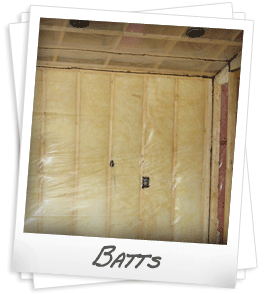Batts
The most widely used insulation for residential construction in our region is an unfaced fiber glass batt. It is a flexible product, composed of small diameter glass fibers, with a resin binder. The majority of its thermal resistance is obtained from the trapped air pockets created by the matrix of spun fibers within the batt, not by the fibers.
— Home Inspection Technical Article
Today’s generation of fiberglass batts do not settle, are non-combustible, resistant to moisture, mold, mildew and rodents. Batt insulation requires the use of a polyethylene air/vapour barrier on the inside for control of air and moisture movement. When properly installed within the building envelopes wood framing (i.e. 2” x 6”), fiber glass batts, combined with a well sealed air/vapour barrier will meet the standards developed by Energuide for a ‘typical new home’, up to an ‘energy efficient new home’. Typically, additional levels of thermal insulation must be added to obtain the ‘highly energy-efficient new house level’ or the ‘R2000 standard’.

Would you like to know more on Batts?
- This product is pre-cut and packaged based on the stud width and spacing common to wood frame construction, for a friction fit insulation
- Individual packs are first labeled based on the R-value with R-12 & R-20 versions representing 2" x 4" and 2" x 6" framing respectively. Secondly, there are also packaged in 15", 19" and 23" widths and suit standard stud, joist and truss spacing (also produced in a range of other R-values up to the R40 batt - e.g. R28 version suitable to 2" x 8" framing). The final difference that will be noted is color, which varies solely based on the different manufacturers.
- CCMC approval listing is available form all major producers and often indicated in the package labeling
Share this with:




